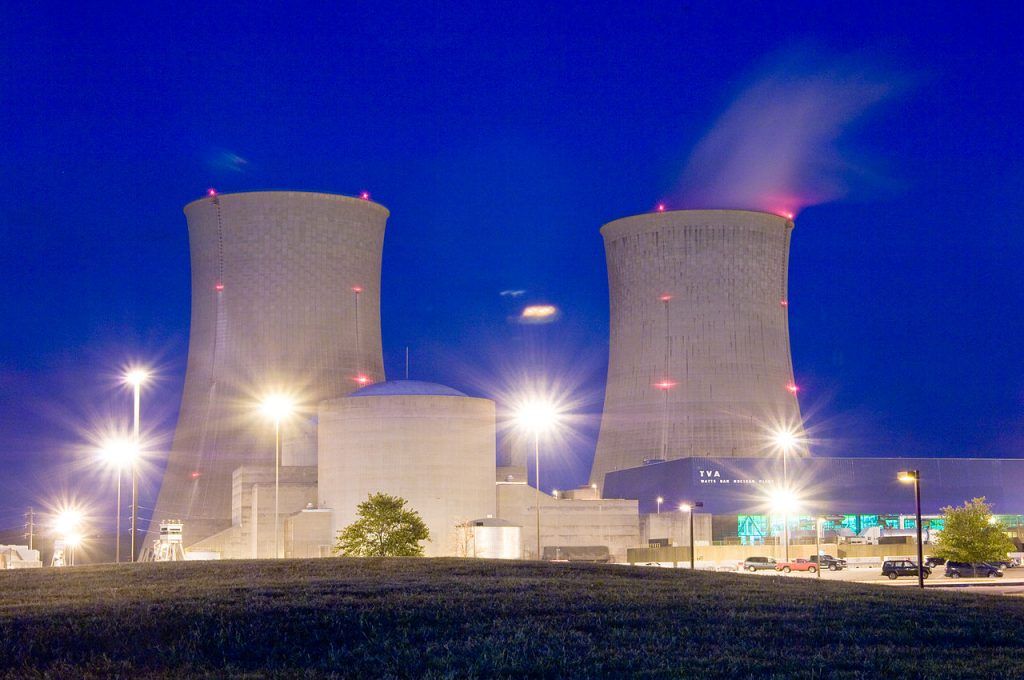The false promise of nuclear power in an age of climate change
By Robert Jay Lifton, Naomi Oreskes | August 20, 2019
 The Watts Bar Nuclear Power Plant Unit 2, located in Tennessee, took more than 40 years to complete.
The Watts Bar Nuclear Power Plant Unit 2, located in Tennessee, took more than 40 years to complete.
Editor’s note: This article was originally published here by the Boston Globe.
Commentators from Greenpeace to the World Bank agree that climate change is an emergency, threatening civilization and life on our planet. Any solution must involve the control of greenhouse gas emissions by phasing out fossil fuels and switching to alternative technologies that do not impair the human habitat while providing the energy we require to function as a species.
This sobering reality has led some prominent observers to re-embrace nuclear energy. Advocates declare it clean, efficient, economical, and safe. In actuality it is none of these. It is expensive and poses grave dangers to our physical and psychological well-being. According to the US Energy Information Agency, the average nuclear power generating cost is about $100 per megawatt-hour. Compare this with $50 per megawatt-hour for solar and $30 to $40 per megawatt-hour for onshore wind. The financial group Lazard recently said that renewable energy costs are now “at or below the marginal cost of conventional generation”—that is, fossil fuels—and much lower than nuclear.
In theory these high costs and long construction times could be brought down. But we have had more than a half-century to test that theory and it appears have been solidly refuted. Unlike nearly all other technologies, the cost of nuclear power has risen over time. Even its supporters recognize that it has never been cost-competitive in a free-market environment, and its critics point out that the nuclear industry has followed a “negative learning curve.” Both the Nuclear Energy Agency and International Energy Agency have concluded that although nuclear power is a “proven low-carbon source of base-load electricity,” the industry will have to address serious concerns about cost, safety, and waste disposal if it is to play a significant role in addressing the climate-energy nexus.
But there are deeper problems that should not be brushed aside. They have to do with the fear and the reality of radiation effects. At issue is what can be called “invisible contamination,” the sense that some kind of poison has lodged in one’s body that may strike one down at any time—even in those who had seemed unaffected by a nuclear disaster. Nor is this fear irrational, since delayed radiation effects can do just that. Moreover, catastrophic nuclear accidents, however infrequent, can bring about these physical and psychological consequences on a vast scale. No technological system is ever perfect, but the vulnerability of nuclear power is particularly great. Improvements in design cannot eliminate the possibility of lethal meltdowns. These may result from extreme weather; from geophysical events such as earthquakes, volcanoes, and tsunamis (such as the one that caused the Fukushima event); from technical failure; and from unavoidable human error. Climate change itself works against nuclear power; severe droughts have led to the shutting down of reactors as the surrounding waters become too warm to provide the vital cooling function.
Advocates of nuclear energy invariably downplay the catastrophic events at Fukushima and Chernobyl. They point out that relatively few immediate deaths were recorded in these two disasters, which is true. But they fail to take adequate account of medical projections. The chaos of both disasters and their extreme mishandling by authorities have led to great disparity in estimates. But informed evaluations in connection with Chernobyl project future cancer deaths at anywhere from several tens of thousands to a half-million.
Studies of Chernobyl and Fukushima also reveal crippling psychological fear of invisible contamination. This fear consumed Hiroshima and Nagasaki, and people in Fukushima painfully associated their own experiences with those of people in the atomic-bombed cities. The situation in Fukushima is still far from physically or psychologically stable. This fear also plagues Chernobyl, where there have been large forced movements of populations, and where whole areas poisoned by radiation remain uninhabitable.
The combination of actual and anticipated radiation effects—the fear of invisible contamination—occurs wherever nuclear technology has been used: not only at the sites of the atomic bombings and major accidents, but also at Hanford, Washington, in connection with plutonium waste from the production of the Nagasaki bomb; at Rocky Flats, Colorado, after decades of nuclear production; and at test sites in Nevada and elsewhere after soldiers were exposed to radiation following atomic bomb tests.
Nuclear reactors also raise the problem of nuclear waste, for which no adequate solution has been found despite a half-century of scientific and engineering effort. Even when a reactor is considered unreliable and is closed down, as occurred recently with the Pilgrim reactor in Plymouth, or closes for economic reasons, as at Vermont Yankee, the accumulated waste remains at the site, dangerous and virtually immortal. Under the 1982 Nuclear Waste Policy Act, the United States was required to develop a permanent repository for nuclear waste; nearly 40 years later, we still lack that repository.
Finally there is the gravest of dangers: plutonium and enriched uranium derived from nuclear reactors contributing to the building of nuclear weapons. The technology needed to enrich uranium to commercial reactor grade can easily be scaled up to enrich uranium to weapons grade. When commercial uranium reactors operate, the fissioning of their fuel produces plutonium, which ends up in the high-level radioactive waste. Wherever extensive nuclear power is put into use there is the possibility of its becoming weaponized. Of course, this potential weaponization makes nuclear reactors a tempting target for terrorists.
There are now more than 450 nuclear reactors throughout the world. If nuclear power is embraced as a rescue technology, there would be many times that number, creating a worldwide chain of nuclear danger zones—a planetary system of potential self-annihilation. To be fearful of such a development is rational. What is irrational is to dismiss this concern, and to insist, after the experience of more than a half-century, that a “fourth generation” of nuclear power will change everything.
Advocates of nuclear power frequently compare it to carbon-loaded coal. But coal is not the issue; it is already making its way off the world stage. The appropriate comparison is between nuclear and renewable energies. Renewables are part of an economic and energy revolution: They have become available far more quickly, extensively, and cheaply than most experts predicted, and public acceptance is high. To use renewables on the necessary scale, we will need improvements in energy storage, grid integration, smart appliances, and electric vehicle charging infrastructure. We should have an all-out national effort—reminiscent of World War II or, ironically, the making of the atomic bomb—that includes all of these areas to make renewable energies integral to the American way of life. Gas and nuclear will play a transitional role, but it is not pragmatic to bet the planet on a technology that has consistently underperformed and poses profound threats to our bodies and our minds.
Above all, we need to free ourselves of the “nuclear mystique”: the magic aura that radiation has had since the days of Marie Curie. We must question the misleading vision of “Atoms for Peace,” a vision that has always accompanied the normalization of nuclear weapons. We must free ourselves from the false hope that a technology designed for ultimate destruction could be transmogrified into ultimate life-enhancement.
Together, we make the world safer.
The Bulletin elevates expert voices above the noise. But as an independent nonprofit organization, our operations depend on the support of readers like you. Help us continue to deliver quality journalism that holds leaders accountable. Your support of our work at any level is important. In return, we promise our coverage will be understandable, influential, vigilant, solution-oriented, and fair-minded. Together we can make a difference.
Topics: Climate Change, Opinion

















https://www.world-nuclear.org/information-library/country-profiles/countries-a-f/france.aspx#targetText=France%20has%2058%20nuclear%20reactors,total%20capacity%20of%2063.1%20GWe.&targetText=It%20also%20has%20an%20extremely,electricity%20is%20nuclear%20or%20hydro.
In France, Nuclear Power is 44 Euro per MW/h, yes it’s subsidized, but so are renewables. There are 58 nuclear reactors producing electricity in France, there have been no major accidents, most issues are due to aging infrastructure, which has been replaced or routinely inspected.
France recycles its nuclear waste and has a funded and operational longterm waste storage plan.
Just because other Nations suck at nuclear power doesn’t mean that Nuclear power is bad.
You are correct that diligent management of nuclear power in France has resulted in a safe record so far. There’s no guarantee that good management will continue into the future, and history shows that there is virtually a guarantee that it will not. You also leave out the fact that not all nuclear waste can be recycled, and it has already been shown that there is no truly safe long-term storage solution for radioactive material. The problem with nuclear power is that when catastrophe does strike, consequences are permanent and disastrous. So nuclear power isn’t bad because it HAS been… Read more »
Their primary nuclear company, which has had various degrees of state ownership, filed for bankruptcy a few years ago, getting write-offs that amount to much higher subsidies/externalities than renewables will ever see. France also does not count the cost of money (interest) in its cost estimates, which results in greatly understating the costs.
Antinuclearism is the very worst kind of climate denialism, because opposing nuclear energy means embracing climate change.
“If we leave coal, if we leave nuclear, then we will need more natural gas. Energy after all needs to be affordable.” — Dr. Angela Merkel, Chancellor of Germany
https://www.climatechangenews.com/2019/01/23/coal-phase-will-increase-german-need-gas-says-merkel/
“If we leave coal, if we leave nuclear, then we will need more natural gas. Energy after all needs to be affordable.” — Dr. Angela Merkel, Chancellor of Germany
She’s wrong. We don’t need natural gas either. Your argument is fallacious.
“Human error” is a soft term for all the possible human actions. Actually one has not to forget that humans are dangerous for themselves not because they may commit inadvertent errors, but more because they can commit deliberate “errors”, some due to stupidity (Chernobyl), some due to corruption (Fukushima), some due to terrorism, act of war etc.
By concentrating so much damage potential in a single place, in a few hands, nuclear power plants are ideal targets for malign people.
All nuclear workers in the US undergo FBI background checks and are compensated well so i highly highly doubt internal sabotage is a serious concern. Nuclear plants are designed to survive earth quakes, tornadoes, hurricanes, 9-11 style attacks they have very well trained security on site so prettty safe from outside attacks too.
I don’t know what nuclear plants you are talking about, but I know for a fact the nuclear plant I work at Operates at $21-22 per megawatt. That is significantly less than the $100 per megawatt this article claims. Also, it appears the figures provided for solar and wind include federal subsidies into the prices being so low. Subtract those subsidies and solar and wind become far less attractive. As far as safety, the US commercial nuclear industry, historically, is one of the heaviest regulated and safest, especially post Three Mile Island. Compare commercial nuclear with oil, gas, coal, etc…… Read more »
The 10% decay heat I presented above is a little high. That 10% would be a very very conservative amount factoring begining of core life and rounding up for a conservatism. The real numbers are closer to 6-7% and even as low as 1-2% toward the end of core life. By enlarge the commercial nuclear industry in the US has gotten more predictable, more reliable, safer and more cost effective in the last 10-15 years or so. With funding towards advancing nuclear power the industry could explore Thorium reactors which you theoretically can press a button and walk away without… Read more »
The article claims the nuclear industry needs to solve these things and aren’t. This is patently false. Molten salts as opposed to pressurized water solves the melt down problem. High thermal load following tanks rather than piles solves this issue entirely. Safety is inherent in all the new designs being developped. The waste problem will be solved by reactor designs that will use existing waste as fuel. The fuel waste thing will be eliminated for good. Costs will plummet with these new designs. Given theres no huge risks of meltdowns or explosions there will not be a need for huge… Read more »
Regarding price we must acknowledge that nuclear can provide electricity 24/7. If you factor battery storage for solar which is 150 USD MW/h the price of solar becomes the same or much worse than nuclear. This is assuming that battery storage can provide 8-10 hour operation.
There is no way to price nuclear power, due to the levelized cost fallacy. LCOE is something devised to make nuclear look good, because the ridiculous up-front price of it all, can be averaged over a stupid amount of time. It’s like going to a car dealer and he makes strenuous arguments that you should buy a very expensive car that lasts 4 times as long. No matter that the extra $100000 you have to pay, has a serious impact on your child’s education, or current finances. You are simply irrational and wrong headed, if you don’t pay 4 times… Read more »
Ever notice how those that talk about science a lot and authoritatively dispense their unquestionable truth, on the science of climate change, the science of covid, the science behind a gay gene or whatever else, seldom actually have a science or engineering degree? As to the rest of this article which is more about feelings and perceptions than actual science and engineering, it’s a complete waste of time and inaccurate. A psychologist and historian need not necessarily ramble nonsense, but they attempt to make their argument without defining terms, any numbers, correlation, causality, reproducible test/model or even identifying all the… Read more »